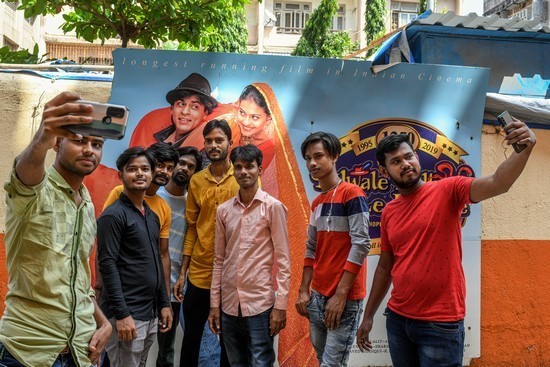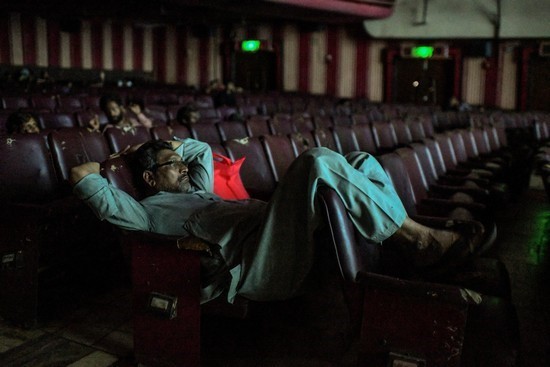MUMBAI, India — Well past the film’s
intermission, the crowd keeps trickling in. Some pay at the ticketing window
with a couple of taps on their phone; others dump fistfuls of coins. They are
students and office clerks, day laborers still chasing dreams in India’s
“maximum city”, and the homeless with dreams long deferred.
اضافة اعلان
India’s film industry puts about 1,500
stories on the screen annually. But the audience that files every morning into
the Maratha Mandir cinema in Mumbai is here for a movie that premiered 27 years
ago — and has resonated so intensely that this once-grand 1,100-seat theater has
played it every day since, save for a pandemic hiatus.
The film, “Dilwale Dulhania Le Jayenge” —
which translates as “The Big-Hearted Will Take the Bride” and is known as
“DDLJ” — is a boy-meets-girl story set against the backdrop of a moment of
immense change and unbridled possibility in India.
The Indian economy had just opened up,
bringing new opportunities, new technologies, and new exposure to a rising
middle class. But it has also brought new strains as the choices afforded by
economic opportunity — to decide your own love and your own life — ran up
against the protective traditions of old.
 People
take selfies with a movie poster for “Dilwale Dulhania Le Jayenge” at the
Maratha Mandir cinema in Mumbai, India, in October 2022.
People
take selfies with a movie poster for “Dilwale Dulhania Le Jayenge” at the
Maratha Mandir cinema in Mumbai, India, in October 2022.
In many ways, the India of today looks like
the India reflected in the movie. The economy is still on the rise, and it is
now about 10 times the size it was in the mid-1990s. A technological revolution
— this one digital — has opened new worlds. Women are seeking more freedom in a
male-dominated society. And the forces of modernity and conservatism remain in
tension as an ascendant political right wing appoints itself the enforcer of
conventional values.
The sense of unlimited possibility,
however, has receded. As the early rewards of liberalization peaked and
economic inequities deepened, aspirations of mobility have diminished. For
those left behind, the world of “DDLJ” — its story and stars, its music and
dialogue — is an escape. For those still striving, it is an inspiration. And
for those who have made it, it is a time capsule, the starting point of India’s
transformation.
The Indian economy had just opened up, bringing new opportunities, new technologies, and new exposure to a rising middle class. But it has also brought new strains…
“It grew and grew and grew and went on to,
you know, become an heirloom,” said actress Kajol, 48, who played the female
lead, Simran, in the film. “I have had so many people who told me that, you
know, ‘We have made our children sit down and watch ‘DDLJ’; we have made our
grandchildren sit down and watch’ — and I was like, ‘There are grandchildren
now?’”
She burst out laughing. “Children I am fine
with. But grandchildren?”
‘I come every day’When the pandemic closed theaters for a
year, many speculated that “DDLJ’s” record run would end. But the film is back
on for its 11:30am slot at Maratha Mandir, often drawing crowds larger than
those at afternoon screenings of the latest releases.
Some of those who show up have watched it
here so many times that they have lost count — 50, 100, hundreds of times.
A taxi driver who was in the line outside
the theater one morning this fall had seen it six times, a welder about a
dozen. A gray-bearded merchant of secondhand goods claimed about 50 viewings,
the same for a 33-year-old delivery worker.
Then there were the regular regulars, those
who trek here nearly every day. Madhu Sudan Varma, a 68-year-old homeless man
who has a part-time job feeding neighborhood cats, comes about 20 mornings a
month.
The woman with her head wrapped in a
plastic bag?
“I come every day,” she said. “I like it
every day.”
No one knows her real name; it may be
Jaspim, but even she is unsure. It does not matter, because everyone calls her
by the name she prefers: Simran, just like the star on the screen.
“I don’t see any other films, just this one,” she said. “I feel great when I come here. I get lost in the songs and dance.”
Lying at night in the room she keeps in
Mumbai’s red-light district, she sometimes dreams of the film’s scenes, she
said. In the morning, she makes sure she does not miss the show — not even on
this day, when the henna she used to dye her graying hair had not yet dried.
She would rather come wearing a plastic bag than not make it.
“I don’t see any other films, just this
one,” she said. “I feel great when I come here. I get lost in the songs and
dance.”
‘Live your life’“DDLJ” is a love story. But it is also
about compromise.
Kajol’s character, Simran Singh, is brought
up in London, though her father uses the income from the family’s corner store
to raise his children in the traditions of India.
On a European trip with friends, Simran
meets Raj Malhotra, played by Shah Rukh Khan, a wealthy young man raised by a
single father. The rest of the film’s three hours are spent on the couple’s
efforts to persuade Simran’s conservative father to let go of the arranged marriage
he had planned for his daughter and bless their union.
“Go, Simran, go,” the father declares at
the end, after the film barrels through tears, bloody fistfights and many songs
of longing. “Live your life.”
Kajol said that the movie’s middle path had
broken new ground. Before “DDLJ”, she said, “we only had films that talked
about either this way or that; either we had films that celebrated marriages
and everybody was involved from uncles to aunties, or it was ‘us against the
world; we will fight it out; we will live together, die together.’ I think
‘DDLJ’ came up with a very simple thought: to say that maybe we can walk a
line.”
Khan’s Cinderella storyWhen the movie was released in 1995, Kajol
and Khan were both relative newcomers. Kajol went on to become one of the most
successful actresses in Hindi cinema. Khan, 57, found even greater fame,
becoming one of India’s most recognizable faces.
Both actors benefited from an Indian
entertainment industry that was itself in transition as money flooded in with
the country’s economic liberalization.
 People
at a screening of “Dilwale Dulhania Le Jayenge” at the Maratha Mandir cinema in
Mumbai, India, in August 2022.
People
at a screening of “Dilwale Dulhania Le Jayenge” at the Maratha Mandir cinema in
Mumbai, India, in August 2022.
Now the country has more than 200 million
households with televisions, up from 50 million then. Many more people can
afford cinema tickets. And India, which recently became the world’s
fifth-largest economy, is expected to have 1 billion smartphone users by 2026.
Film stars have become permanent fixtures
on billboards and on television commercials. India is a huge market — it is
projected to soon pass China as the world’s most populous country — and a
star’s simple post of sponsored content on platforms like Instagram can be
lucrative. Actors who would once perform in different films in the same change
of clothes now find themselves with unfathomable wealth.
Bollywood has long favored those with legacy
and family ties. Khan resonates as an outsider, a child of middle-class
struggle in Delhi who lost both of his parents when he was young.
The towering residence he now occupies with
his family “is a middle-class monument to a man who didn’t own property”, said
Indian economist Shrayana Bhattacharya. “He became this prism and this concept.
He represents this idea of mobility.”
Bhattacharya wrote a book, “Desperately
Seeking Shah Rukh”, about how Khan symbolizes the possibilities that only
India’s liberalized economy could produce and what he has meant to young
working women as he has challenged perceptions of masculinity in Indian cinema.
Taking advantage of new channels of
information, he has built an image of an empathetic partner who listens, helps
with household chores, and shares the spotlight with female co-stars.
Bollywood has long favored those with legacy and family ties. Khan resonates as an outsider, a child of middle-class struggle in Delhi who lost both of his parents when he was young.
The power of this image, he said in one
interview, has become such that he has become “an employee of the myth of Shah
Rukh Khan”. It is so potent that young women, Bhattacharya said, “want to be
him” rather than want to “marry him”, the emotion usually associated with older
matinee idols.
Between tradition and modernityIndia is still trying to decide where to
set the line that “DDLJ” suggested it walk between conservatism and modernity.
Added to the tension is a Hindu-first fervor under Prime Minister Narendra
Modi, with Muslims in particular becoming a target. Khan, despite his
crosscutting appeal, has not been spared.
This month, right-wing groups vandalized
cinemas promoting Khan’s latest film after a trailer showed its female star,
Deepika Padukone, wearing a saffron bikini. The groups called the choice of
saffron an offense to Hinduism, which is closely associated with the color.
Khan is a product of a secular India — a
Muslim who attended a Christian school and married a Hindu. Faced with attacks
like these, he has largely stopped commenting on the country’s political
direction.
“I am a Muslim, my wife is a Hindu, and my
kids are Hindustan,” Khan said on a television show in 2020, using another word
for India. “When they went to school, they had to write their religion. My
daughter came to me once and asked, ‘What is our religion?’ I simply wrote in
her form that we are Indian.”
Read more Lifestyle
Jordan News







